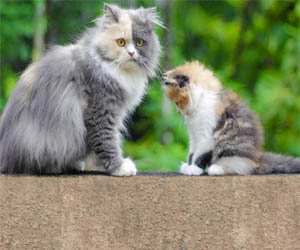


Unraveling The Enigmatic Feline Nature

Cats, with their graceful movements, mysterious behaviors, and distinctive personalities, have been captivating human hearts for centuries. Yet, despite their prevalence as domestic companions, understanding cats can often be a puzzling endeavor. In this article, we'll delve into the intricacies of feline nature to help you gain a deeper appreciation and connection with these enigmatic creatures.
1. Independent Yet Affectionate: Cats are renowned for their independent nature. They may not always crave attention like dogs, but when they do, their affection is genuine and heartwarming. Understanding your cat's need for personal space while cherishing those moments of cuddles is a key aspect of feline companionship.
2. Communication Through Body Language: Cats are skilled communicators, and their body language speaks volumes. Pay attention to their tail, ears, and whiskers, as these are indicators of their current mood. For example, a flicking tail may signify annoyance, while a content cat typically holds its tail upright.
3. The Language Of Purring: One of the most intriguing aspects of cat behavior is purring. Cats purr for various reasons: contentment, comfort, and even as a self-soothing mechanism. Understanding the context and accompanying body language can provide insights into the purpose of their purring.
4. Instinctual Behaviors: Cats retain many of their wild instincts, including hunting and territorial marking. Scratching furniture and kneading are instinctual behaviors, and providing outlets for these urges, like scratching posts, is crucial for a happy indoor cat.
5. The Night Owl Nature: Cats are crepuscular animals, which means they are most active during dawn and dusk. This natural behavior may explain why your cat seems most playful and energetic during these times. Creating a stimulating evening routine can help channel their energy positively.
6. Play Is Serious Business: Play is not just a source of entertainment for cats; it's also a way for them to hone their hunting skills. Engage your cat in interactive play with toys that mimic prey, which can satisfy their instincts and provide exercise.
7. Socialization And Territory: Cats are territorial animals. They may be wary of unfamiliar cats or even new people in their home. Proper socialization early in life and gradual introductions to new situations can help reduce stress and ensure a contented cat.
8. Grooming Rituals: Cats are meticulous groomers, not only to stay clean but also to bond with other cats or humans. They may groom their companions as a sign of affection. Reciprocating with gentle petting can enhance your bond.
9. Unique Personalities: Each cat is an individual with its own distinct personality. Some may be outgoing and adventurous, while others are reserved and cautious. Understanding your cat's personality can help you tailor your interactions to their needs.
In summary, understanding cats goes beyond observing their behaviors; it involves interpreting their cues, respecting their individuality, and creating a nurturing environment. The bond between humans and cats is a complex yet rewarding one, founded on trust, empathy, and an appreciation for the enigmatic charm of our feline friends. As you invest time in understanding and connecting with your cat, you'll find that the mysteries of their behavior only add to the depth of your relationship.
A Sustainable Path Forward
 2. Composting Organic Waste
2. Composting Organic Waste
A significant portion of landfill waste consists of organic materials such as food scraps and yard trimmings. Composting these materials not only reduces the volume of waste going to landfills but also produces valuable compost that can enrich soil and support sustainable agriculture. Composting is a simple yet effective way to reduce the environmental impact of landfill waste.
3. Waste-To-Energy Technology
Waste-To-energy (WTE) technology, as discussed in previous articles, is a powerful strategy for diverting waste from landfills and generating clean energy simultaneously. By incinerating waste at high temperatures, WTE facilities can significantly reduce waste volume and produce electricity and heat, making it a win-win solution for waste management and sustainable energy production.
4. Circular Economy Initiatives
The concept of a circular economy emphasizes designing products with end-of-life considerations in mind. Instead of creating products that become waste, the goal is to create items that can be repaired, reused, or easily recycled. This approach minimizes the need for landfill disposal and encourages resource conservation.
5. Extended Producer Responsibility (EPR)
EPR is a policy approach that places responsibility on manufacturers for the entire life cycle of their products, including the post-consumer phase. It encourages companies to design products that are easier to recycle and manage at the end of their life, thus reducing the waste that ends up in landfills.
6. Reducing Single-Use Plastics
Single-use plastics are a major contributor to landfill waste and environmental pollution. Strategies such as banning certain single-use plastics, promoting reusable alternatives, and encouraging recycling programs can significantly reduce the volume of plastic waste in landfills.






Decrypting The Language Of The Fields
 Geometry And Sacred Symbols
Geometry And Sacred Symbols
Crop circles often feature complex geometric shapes and patterns. Some of the most common elements in these formations include circles, triangles, spirals, and fractals, all of which hold significant symbolism in various cultures and belief systems. These patterns have been associated with concepts like unity, balance, and the infinite nature of the universe.
Mandalas And Spiritual Significance
Mandalas, intricate geometric designs that represent the universe in Hindu and Buddhist traditions, are often found in crop circle patterns. These mandalas symbolize unity and wholeness, and they are believed to help connect the individual to a deeper sense of self and the cosmos. Crop circles bearing mandala-like designs are seen by some as invitations to explore spiritual realms.
Celestial Alignments
Crop circles have also been linked to celestial bodies and astronomical phenomena. Some formations appear to align with the positions of stars, planets, or constellations, leading to speculation about their potential astronomical symbolism. Some proponents of the cosmic symbol theory argue that these patterns serve as maps or markers related to celestial events or extraterrestrial contact.
Mathematical Precision
The mathematical precision found in crop circle patterns adds to their cosmic allure. The use of mathematical concepts and equations, including fractals and Fibonacci sequences, suggests a level of knowledge and intelligence beyond the realm of human creation.
Separating Fact From Fiction
 One of the most frequently cited quatrains related to an end-of-the-world scenario is Quatrain 72 from Century 10, which reads:
One of the most frequently cited quatrains related to an end-of-the-world scenario is Quatrain 72 from Century 10, which reads:
"The year 1999, seventh month,
From the sky will come a great King of Terror:
To bring back to life the great King of the Mongols,
Before and after, Mars to reign by good luck."
This quatrain has been linked to a variety of doomsday scenarios, including fears of an asteroid impact, a nuclear apocalypse, or even an extraterrestrial invasion. However, as the year 1999 came and went without the prophesied catastrophe, it became evident that Nostradamus' predictions should not be taken as literal forecasts of the end of the world.
Nostradamus himself wrote in cryptic and metaphorical language, making it difficult to attribute specific dates and events to his quatrains with certainty. His quatrains often relied on symbolic imagery and allegory, which leaves considerable room for interpretation. This ambiguity, combined with the allure of doomsday scenarios, has led to post-event retrofitting, where events are interpreted to fit Nostradamus' verses after they occur, rather than the other way around.
The concept of the end of the world has fascinated humans for millennia, and Nostradamus is not the only figure whose writings have been scrutinized for signs of impending doom. Believers in doomsday predictions often rely on selective interpretation, pointing to a few quatrains that seem to match their concerns while neglecting the vast majority that do not.
Unleashing Canine Athleticism And Bonding
 What Is Agility Training?
What Is Agility Training?
Agility training is a dog sport that involves navigating a timed obstacle course. These courses can vary in complexity but typically include jumps, tunnels, weave poles, A-frames, and seesaws. The dog's task is to complete the course as quickly as possible, following their handler's commands and without knocking down any obstacles. The sport is not just about speed; it also requires precision and teamwork between the dog and their owner.
Physical Exercise And Mental Stimulation: Agility courses provide dogs with an excellent physical workout. Running, jumping, climbing, and weaving through obstacles help maintain a dog's fitness and health. This is especially beneficial for high-energy breeds, as it allows them to expend their excess energy in a constructive way. In addition to physical exercise, agility training offers significant mental stimulation. Dogs must follow commands, make quick decisions, and memorize the course, which challenges their cognitive abilities.
Building A Strong Bond: One of the most remarkable aspects of agility training is the bond it creates between dogs and their owners.
Techniques For Awareness In Dreams
 Keep A Dream Journal: A dream journal is a crucial tool for developing lucid dreaming skills. Keep it by your bedside, and as soon as you wake up, jot down the details of your dreams. This practice enhances your dream recall, helping you identify recurring themes and symbols.
Keep A Dream Journal: A dream journal is a crucial tool for developing lucid dreaming skills. Keep it by your bedside, and as soon as you wake up, jot down the details of your dreams. This practice enhances your dream recall, helping you identify recurring themes and symbols.
Mnemonic Induction Of Lucid Dreams (MILD): The MILD technique involves setting a strong intention to remember your dreams and become lucid. Before falling asleep, repeat a mantra or affirmation to yourself, such as "I will become aware that I'm dreaming." The key is to truly believe in the intention.
Wake-Back-To-Bed (WBTB): The WBTB technique involves waking up in the middle of the night and then going back to sleep with the intention of becoming lucid. By disrupting your sleep cycle and returning to slumber, you increase the chances of entering a dream directly into a state of awareness.
Visualizations: Visualization techniques involve imagining yourself in a lucid dream scenario before falling asleep. This helps your subconscious mind prepare for the experience and increases the likelihood of becoming aware during the dream.
Progressive Muscle Relaxation: Relaxation exercises, such as progressive muscle relaxation, can help induce a calm and focused state before sleep. A calm mind and body can make it easier to enter the dream world with awareness.
Wake-Induced Lucid Dream (WILD): WILD is a technique that involves transitioning directly from wakefulness into a lucid dream. It requires concentration and awareness during the transition between wakefulness and sleep, often during a brief waking period in the middle of the night.
Hypnagogic State Exploration: Hypnagogia is the transitional state between wakefulness and sleep. Observing the visual and auditory hallucinations that often occur during this state can lead to lucid dream induction.